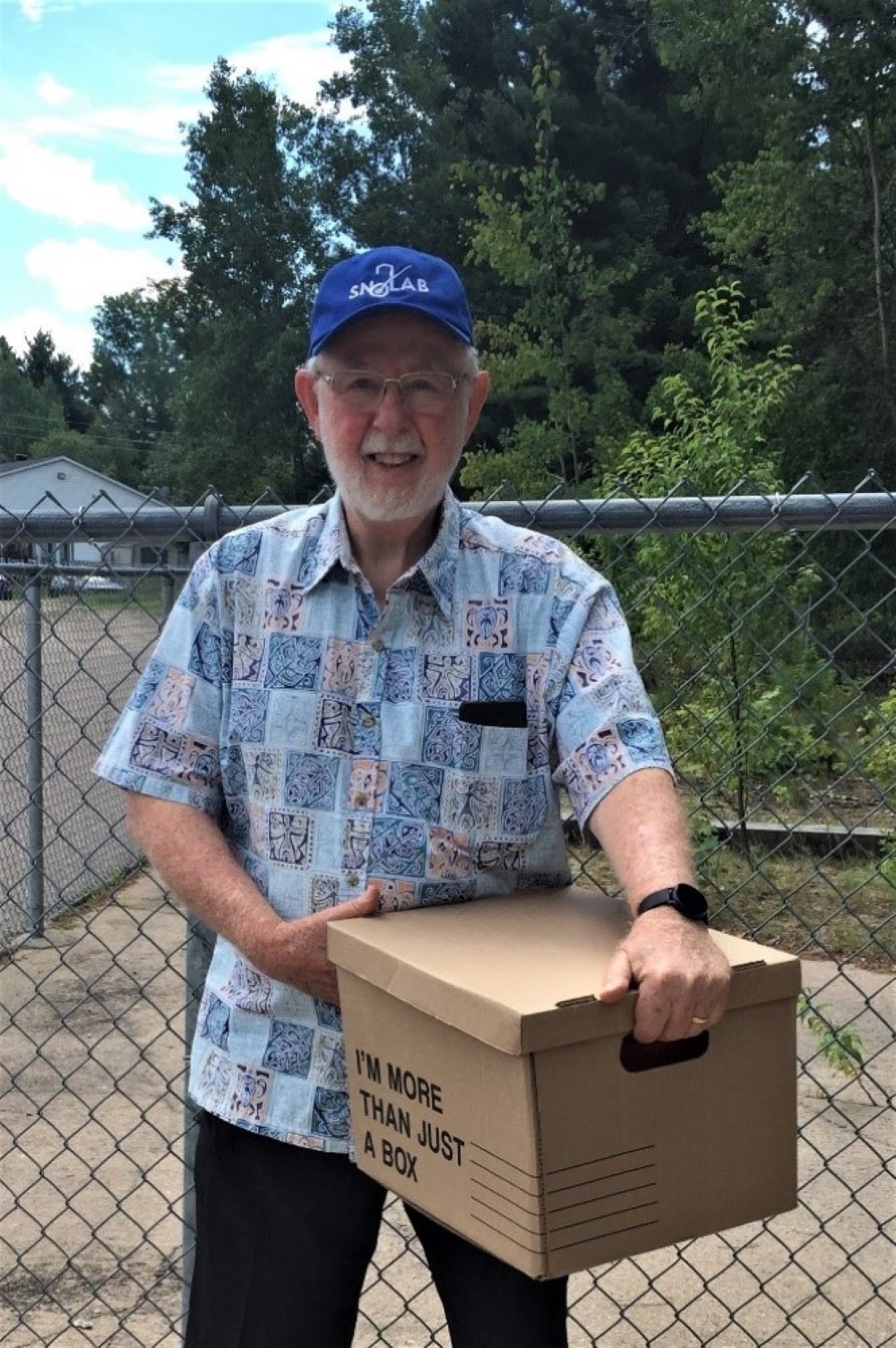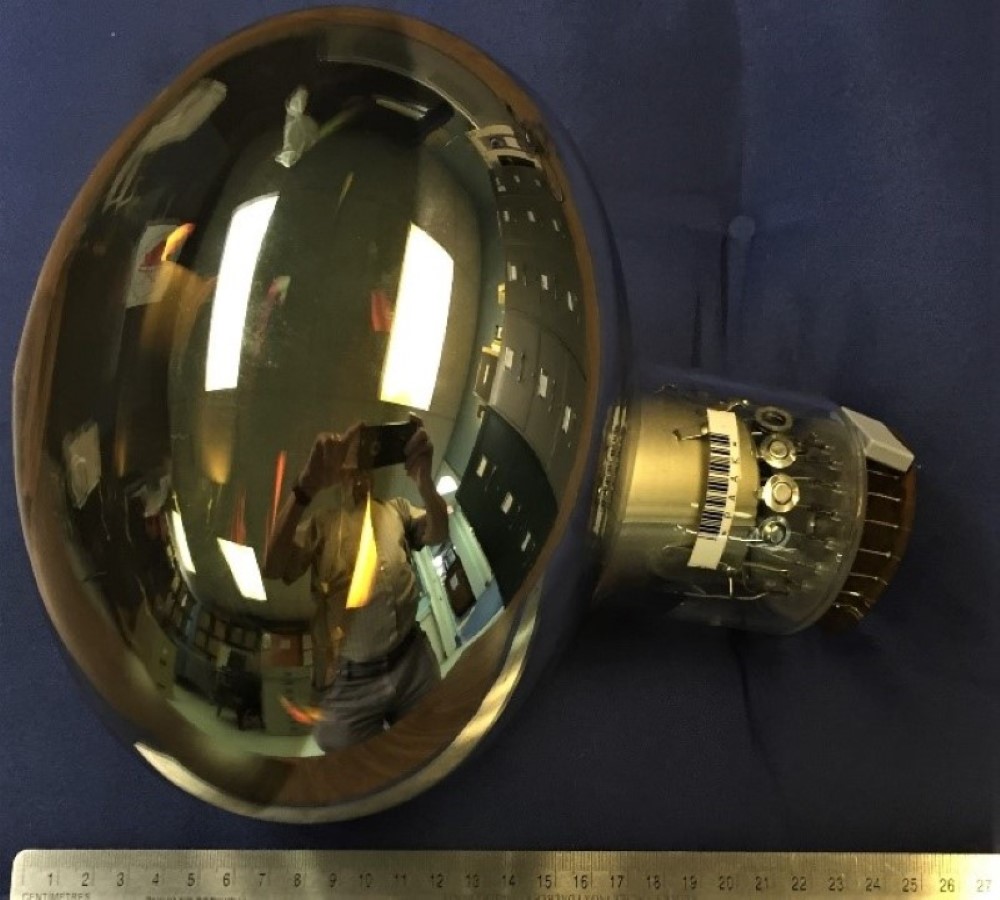
The Society for the Preservation of Canada’s Nuclear Heritage recently acquired a significant addition to its artifact collection. The photomultiplier tube (PMT) pictured is one of about 9500 such PMTs used in the Sudbury Neutrino Observatory (SNO) to detect light resulting indirectly from the products of neutrino interactions in the 1000 tonnes of heavy water that was used in SNO, a lab constructed two kilometres underground in an excavation connected to the Creighton nickel mine near Sudbury. Fittingly, the PMT was delivered personally by Art McDonald (pictured), who shared the 2015 Nobel Prize in Physics as a result of the work he directed at SNO, which resolved the long-standing “solar neutrino problem”. Let’s back up and unpack that achievement a bit.
The idea that there exists a rarely observable particle that we now call a neutrino was conceived more than 90 years ago in order to reconcile a problem in beta decay of apparent violation of conservation laws considered by physicists to be sacrosanct. The neutrino’s existence was experimentally confirmed in 1956, resolving the problem of missing energy and momentum. Indeed, by 1975 the three types (referred to as flavours) of neutrinos we now know to exist had either been detected or inferred. (Bruno Pontecorvo, one of Chalk River’s prominent physicists in the late-1940s, published a number of papers about neutrinos during his tenure at Chalk River and afterwards.)
By far the most intense source of neutrinos seen at Earth is the Sun. The nuclear processes in the Sun produce neutrinos of only one flavour, the one first detected in 1956. The most sensitive detectors developed beginning in the mid-1960s to study solar neutrinos could detect neutrinos of only one flavour, but the same flavour as that produced in the Sun, so all well and good. But there was a problem! The number detected was only a fraction (as low as one third) of the expected number derived from solar models. It appeared that there was something either about the Sun or about neutrinos that wasn’t understood.
The possibility that neutrinos could change flavour during transit had been suggested by Pontecorvo and others in the 1960s. Further, it was known that heavy water as the detection medium could in principle be used to detect two things: neutrinos of the flavour created in the Sun, and neutrinos of all three flavours in aggregate, as two concurrent but distinguishable measurements. Thus, given a large enough detector volume and low enough ionizing radiation background, it could be determined whether or not neutrinos were changing flavour during transit between their creation and their detection.
Canada was the place to do it at a bargain price. A very deep mine, whose overcover could attenuate extremely penetrating cosmic ray secondary particles that would otherwise swamp the weak neutrino signal, already existed near Sudbury, and $300 million dollars worth of heavy water, in reserve from the CANDU reactor program, could be borrowed from AECL. The SNO collaboration, formed in 1984, received funding commitments in 1989, and construction was completed by 1998.
A more vexing problem than cosmic rays was that of radiation emitted from natural radioactivity, which could create false neutrino counts. Minimizing this required strict control of radionuclide content of structural and detector component materials, including the 1000 tonnes of heavy water with its transparent acrylic vessel, and the PMTs and the structure securing them outside the vessel. The cavity (the height of a ten-story building) containing the entire structure was polymer-lined to reduce radon ingress, and was filled with 7000 tonnes of ultrapure ordinary water to attenuate the radiation from the surrounding rock. Substantial water purification and assay systems were required to keep both heavy-water and light-water inventories ultrapure. The lab outside the detector was also kept to enhanced clean-room standards. Even so, intricate research and data analysis were required to differentiate true neutrino events from false counts.
SNO collected data in three phases from 1999 to 2006, but by 2002 it was already clear that neutrinos were changing flavour. The total neutrino count was triple the count of the single flavour created by nuclear processes in the Sun. This observation solved the solar neutrino problem, validated solar models, and also implied that neutrinos have mass. This has implications for astrophysics (neutrinos being the most abundant particles that have mass), and necessitates an update to the standard model of particle physics.
This achievement was recognized (along with a parallel achievement looking at atmospheric neutrinos at the Super-Kamiokande detector in Japan) by the Nobel Prize Committee in jointly awarding the 2015 Nobel Prize in Physics to Takaaki Kajita and Art McDonald. The Society for the Preservation of Canada’s Nuclear Heritage is excited to have an artifact from this historic achievement.
In addition to personally delivering the PMT, Art McDonald volunteered to be one of the people to be video-interviewed by the Society in its present series of interviews. After a busy day at a locally held workshop on newly-planned experiments at SNOLAB, Art was interviewed on August 22.

